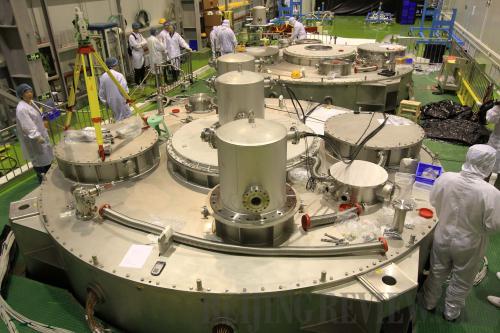|
 |
|
NUCLEAR COOPERATION: Technicians work at the neutrino experiment facility of the Dayawan reactor in Guangdong Province. Since 2006, an international research team from 39 institutes in six countries are involved in the facility (LI MINGFANG) |
After a yearlong suspension, construction of nuclear power facilities across China may be starting up again, signaling the resumption of a 1-trillion-yuan ($158.73 billion) nuclear investment across the country.
In February, Harbin Electric Corp., one of China's major nuclear power equipment producers, received an order for the main components required in nuclear power generation from Tianwan Nuclear Power Plant, located in Lianyungang, east China's Jiangsu Province. This was the first order since the country suspended nuclear power projects last March following the nuclear disaster at Fukushima, Japan.
Although nothing official has been announced, industry insiders say the suspension has been lifted, as the construction of the No.1 generating unit of Sanmen Nuclear Power Plant in east China's Zhejiang Province restarted, and three nuclear power-related planning reports were recently submitted to the State Council for review. The reports are expected to be officially released later this year.
After the nuclear accident at Fukushima on March 11, 2011, Chinese Premier Wen Jiabao chaired a State Council meeting on March 16 and made four decisions on China's nuclear power development: A complete safety check was required immediately on all nuclear facilities; approval of newly built nuclear power projects will be tightened; formulation of a nuclear safety plan will be accelerated; middle and long-term development plan of nuclear power will be readjusted, and before the plan is approved, approval of nuclear power projects, including preliminary work of the projects, should be suspended.
Following the meeting, a nation-wide safety screening on all operational and under-construction nuclear power facilities was put into effect, with approval of some construction projects suspended outright. From April 15 to August 5, the comprehensive check group on national civil nuclear facilities jointly organized by the National Nuclear Safety Administration (NNSA) of the Ministry of Environmental Protection (MEP), the National Energy Administration (NEA) and some other departments checked all the country's power plants.
The safety check drew lessons from the Fukushima accident, forcing many nuclear power operators to take a more aggressive approach to nuclear power safety.
On January 21, the generating units at the Ling'ao Nuclear Power Plant in south China's Guangdong Province were upgraded, which ended on February 10. The overhaul showed that the plant was in good condition. Starting on February 12, the generators at Tianwan began a 50-day overhaul, including 8,436 checks on individual components and technological upgrades.
Wang Binghua, Chairman of the State Nuclear Power Technology Corp., said besides safety check of nuclear power facilities in operation, designing, equipment manufacturing and construction of projects with third-generation AP1000 technology have been slowed down.
In fact, the AP1000 projects in Sanmen and Haiyang, east China's Shandong Province are safer than second-generation technology used at Fukushima. But China still places safety, not just technology upgrading, as its top priority in the construction of the third-generation nuclear power technology.
According to NEA's Readjustment Plan of Middle and Long-Term Development of Nuclear Power, which has been submitted to the State Council for approval, China plans to install a total nuclear power capacity of 80 million kilowatts (kw) by 2020.
Donghai Securities Co. Ltd. estimated that at least 60 million kw of nuclear power installed capacity will be added by 2020, excluding the capacity under construction now, which will drive up investment by 1.2 trillion yuan ($190.48 billion).
A plan previously issued by the National Development and Reform Commission says by 2020 the proportion of renewable energy among primary energy consumption will reach 15 percent, but in 2011, the proportion was only 8.9 percent, and nuclear power only accounted for 1.038 percent of the country's primary energy consumption.
| 